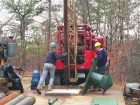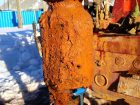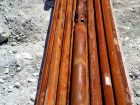
Features
Education
Research
Water-well remediation
Chemical methods can combat common issues
August 26, 2015 By Michael Kleespies
 Here a surge block is used with a drill rig in the well-rehabilitation process. Photo courtesy of CETCO Drilling Products
Here a surge block is used with a drill rig in the well-rehabilitation process. Photo courtesy of CETCO Drilling ProductsI like to compare maintaining a water well to owning a vehicle. My first car was a Honda Accord. At 16 years old, the last thing I wanted to do was spend money on maintenance. I skipped changing the oil; I never considered that the many filters in the car needed to be replaced.
It did not take long before the car developed problems. Over the several years that I owned that car, it broke down several times. The breakdowns always resulted in a large bill to get the car up and running again.
Needless to say, I learned the lesson that a car needs regular maintenance to perform at its best. Regular maintenance also helps extend the life of your vehicle.
The same holds true for a well. Like a car, a well should have a scheduled well-maintenance plan. In the long run, it will extend the life of the well; keep it running efficiently and at full capacity; and save the well owner the costs associated with replacing pumps or drilling a new well.
To have a well drilled is an investment for a homeowner. A water well should provide a reliable, consistent source of good-quality drinking water that should also last for a long period of time.
It’s important to properly maintain a water well. To do so, you must understand the attributes of the well. A lot of people do not think about the importance of their water supply until something happens and they lose access to water.
How often a well needs to be serviced is a function of its geology. The geology of the aquifer type will also dictate the quality of the water. A well drilled in an alluvial deposit will need more frequent maintenance than a well drilled in a limestone aquifer. Other aquifer types include sandstone, interbedded sandstone and shale, and consolidated sedimentary. The majority of well-production problems will fall under three conditions. These issues can be limited by both a properly constructed well and regular maintenance (including well rehabilitation).
Basic preventive maintenance costs are roughly 10 to 20 per cent of the cost for a full well rehabilitation. A full well rehabilitation is roughly 10 to 20 per cent of the cost of having a new well drilled. Like a car, the cost to fix a well that you have not maintained will increase rapidly the longer you put it off.
MINERAL SCALE
Mineral scale is a very common cause of reduced well production or complete failure. This mineral incrustation is caused by the precipitation of dissolved minerals on the well screen and pump from the ground water. The chemistry of the ground water has the biggest influence in determining how quickly this scale will build up. The chemistry of the ground water in turn is determined by the geology of the aquifer. The regular use of water wells and the high velocity at which the ground water is pulled through the screens and into the pump accelerate the deposits of the incrustation. The colour of the mineral scale can give an indication of the type of scale:
- iron = red/brown
- manganese = black
- sulphates = green/blue
- calcium = white
Periodically testing the ground water for concentrations of these substances will allow you to come up with the frequency of maintenance required for the well.
BIOFOULING
Biofouling is caused by the accumulation of bacteria on the well screen and pump. This phenomenon is caused when naturally occurring bacteria interact with the components of the well and form a slimy deposit often referred to as iron bacteria. The problems associated with bacteria buildup are clogged screens and a reduction of pump efficiency. The buildup of living and dead bacteria can accumulate quite rapidly and can cause the start of mineral incrustation. Symptoms of a well affected by biofouling include a quick decline in the output of a well due to clogged screens and biofilm on pumps. The problem can also lead to reduced water quality resulting in the water having a bad odour or even a greasy sheen. In the long term, excessive biofilm can also cause corrosion of the well.
PHYSICAL PLUGGING
As water is pumped from a well, the resulting turbulence in the aquifer may slowly lead to the deposition of fine particles in the water-bearing formation. This often results in a slow reduction in the capacity of the well over the long term. Typically, this is not much of a problem if the well is cleaned out (developed) properly when constructed. A well that has been developed sufficiently in the construction stage removes remnants of bentonite drilling fluid and fines deposited during the drilling stage. Well corrosion resulting in pits and holes forming on the well screen or casing will also lead to the accumulation of sediment in the well. Physical plugging is also a result of the use of the well beyond its design capacity.
In order to maintain your well and determine if one or more of these problems may need to be addressed, a homeowner requires some benchmark information. In the event that a homeowner switches contractors, the following information is needed as a reference to determine a reduction in the performance of the well:
- static water level (the elevation of the standing water in the well)
- specific capacity of the well as determined by a pump test (along with pump rate, pump level, pumping time)
- water-quality analysis
- depth of the well
Because all new wells in Canada must be registered, this information can be found if misplaced or not provided when purchasing an existing property with a well. A basic rule of thumb is that well rehabilitation is required if the specific capacity of the well is reduced by 25 per cent or more.
REHAB METHODS
A well is typically rehabilitated using a combination of mechanical cleaning and well-rehabilitation chemicals. Some companies use other techniques such as heat or shockwaves. A brief description of a typical well-rehabilitation process starts with using a mechanical brush to loosen up and facilitate the removal of mineral scale and biofouling. This works the same way as a chimney brush. This is followed up by the introduction of a surfactant, which is surged through the well over a period of time to soften and loosen the incrustation by increasing surface tension. The surfactant will open up access to fissure and cracks within the buildup.
Once the surfactant has had sufficient time to work, it is purged from the well. The well or pump contractor will then dose the well with a chemical designed to dissolve, suspend and carry out the bacterial deposit that has built up in the well. This process may be quick or may take 24 hours or more, depending on the severity of the deposit. The chemical should be moved throughout the well at this time through the use of surging, jetting, displacement or recirculation. This allows for the penetration of the chemical and removal of the biofilm in the well and surrounding area. As this chemical is an acid, the pH is monitored to determine if the acid is degrading and more needs to be added.
Once the well water returns to neutral or is pumped out, another chemical is added to tackle the mineral incrustation. As mineral scale is often very hard, it may take longer to break down and dissolve. Again, this acid must be surged through the well into the formation. A cable-tool rig is particularly useful to surge or jet a well through the well-rehabilitation process.
When it is determined that the mineral scale has been removed, the well is pumped clean of the chemical and it can then be chlorinated. At this point, the specific capacity of the well is tested and recorded. Well rehabilitation should always be performed by a licensed contractor.
A little education as well as a good working relationship between a well and pump contractor and a well owner will ensure that a water well runs efficiently and produces the best quality water based on the geology of the aquifer. A water well, like a vehicle, requires regular maintenance and TLC to keep it in good operating condition.
Michael Kleespies is the Canadian Territory Manager for CETCO Drilling Products, a manufacturer of high-quality drilling fluids, bentonite grouts and sealants, and well rehabilitation chemicals. CETCO serves the water well, environmental, geothermal and construction drilling markets.
Print this page


